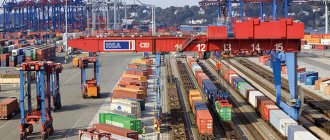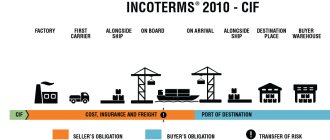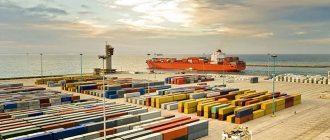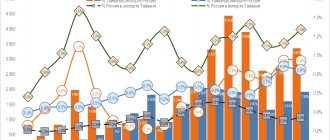Experts unconditionally consider sea transportation to be one of the most effective modern methods of moving goods over long distances. Compared to their competitors - transportation by road, rail, and aircraft - transportation by sea usually requires much lower costs. The main advantage of this method of cargo transportation is that it does not require special infrastructure, which is especially beneficial when transporting large-sized goods.
Rules for the carriage of goods by sea.
What transport is used
Over the thousand-year practice of sea cargo transportation, a whole arsenal of special vessels has been developed to carry it out. Carries out water transport transportation of a wide variety of goods of a wide range. These are grains, petroleum products, all kinds of equipment, food products, etc., including large ones. Sea cargo transportation requires a wide network of special containers with powerful fastenings, and other necessary devices and conditions depending on the type and characteristics of the cargo. To provide all types of sea transportation, vessels are used in the form of:
- Ro-Ro carriers - specially equipped vessels for the targeted transportation of large-sized cargo, equipment, wagons, etc., for which the use of pallets, horizontal and vertical options for loading and unloading cargo is widely practiced;
- bulk carriers - ships that, during transportation, are filled with coal, sand, grain, crushed stone and other bulk cargo. Such vessels are built in the form of huge containers, divided into autonomous compartments that can be hermetically sealed with lids;
- ferries, which are a type of ro-ro. Ferries, as a rule, are built in the form of a number of tiers, the lower of which are intended specifically for transporting goods, and the upper ones can also be used for transporting and servicing passengers. On ferries, all loading work is carried out in a horizontal format;
- tankers, which are now the most popular cargo ships for transporting oil, products made from it, liquefied gas and other liquid cargo. Then the cargo is pumped into tankers using powerful pumps. In addition, tankers are used to transport bulk cargo;
- Container ships carrying many special containers for transporting exclusively goods. These containers are securely fastened; there are clear, practice-tested methods for loading them and placing them on deck;
- dry cargo ships – vessels designed for transporting meat, fish, other food products, as well as dry cargo and various non-standard equipment.
The advantage of dry cargo ships is that in any port they can load and unload goods autonomously, on their own.
Types of containers used
Today, the following types of boxes are used for container shipping:
- standard – the most popular type of sea containers with one 2-leaf door;
- two-door – containers with the ability to load from two opposite sides;
- bulk (Bulk) – for transportation of bulk products;
- isothermal and refrigerated - equipped with systems for maintaining a certain temperature regime;
- Tank containers are in the form of tanks placed in a metal frame for the transportation of liquid substances and liquefied gases.
- Hard/Open Top – for loading goods through the top (thanks to the removable roof);
- Flat Rack – an open type of container (without a roof and side walls) for oversized cargo;
- Open Side – with a fully opening side wall.
Importex specialists also select the appropriate type of container for sea cargo transportation. The choice is made taking into account the weight, dimensions and other characteristics of the cargo.
Advantages of transportation by sea
The main, economically and technologically advantageous advantage of transporting goods by water is the absence of the need for special infrastructure, which is especially beneficial when transporting large-sized cargo. In terms of transportation costs, this is most often the most acceptable option, which also has many other advantages. Experts consider the main advantages of container transportation to be the indisputable fact that in this case, complete safety and inviolability of the goods placed in containers are guaranteed. The clear advantage of shipping by sea is its versatility: it has no restrictions on the volume of cargo or its type. In addition, containers make it possible to quickly load and unload goods at seaports.
Legal basis
First of all, we should dwell on the legal basis of maritime transport contracts governing the mechanism of international forwarding of goods. The main international instruments currently in force are two: the International Convention for the Unification of Certain Rules of Law Relating to Bills of Lading (Hague Rules), developed by the International Maritime Committee and which entered into force in June 1931, and the UN Convention on the Carriage of Goods by Sea (Hamburg Rules) of 1978, developed by the United Nations Commission on International Trade Law (UNCITRAL) and entered into force in November 1992. The main difference between these conventions is the amount of data that must be included in transport documents. Thus, the Hague Rules established that the minimum number of elements to be reflected in each document is three, and the Hamburg Rules increased the number of such elements to fifteen (there are also some other non-fundamental differences). In Russian legislation, the priority source of law, of course, is the Civil Code of the Russian Federation, in which transport and forwarding activities are regulated by Ch. 41 (Art. 801 - 806). The direct sources of national legislation in the field of maritime transportation are the Merchant Shipping Code of the Russian Federation, or the Maritime Code, the Code of Inland Water Transport of the Russian Federation, Federal Law of June 30, 2003 N 87-FZ “On Transport and Forwarding Activities”, Rules of Transport and Forwarding Activities approved by the Resolution Government of the Russian Federation dated 09/08/2006 N 554. In foreign trade, trade customs and documents developed and adopted by the International Federation of Freight Forwarding Organizations (Federation Internationale des Associations de Transitaires et Assimiles - FIATA) and the International Chamber of Commerce (ICC) have been used as generally accepted rules ). ICC is an international non-governmental organization of private entrepreneurship that has developed rules for the interpretation of international trade terms - Incoterms, which have now been published in seven editions. The purpose of this document was to establish uniform interpretation of the terms of the contract for the sale and purchase of goods with their movement across the customs borders of states (Incoterms 2010 contain 11 trade terms). Incoterms terms directly related to the transportation of goods by sea will be discussed below. International transport documents are divided into two types: those that do not have the properties of securities and those that have these properties. In sea transportation, the first type includes, for example, a sea waybill (Seaway Bill), and the second type - a bill of lading (Bill of Lading). The main legal meaning of drawing up a transport document in accordance with the contract is to establish the responsibility of the carrier to the sender of the goods in the event of its loss or damage (the contract itself provides requirements for the contents of the transport document). Currently, various international organizations in the field of transport and forwarding activities are striving to standardize and unify transport documents. However, it is generally accepted that there is still no significant degree of standardization in maritime transport. There is still a tradition according to which each carrier has its own form of transport document. But here, too, a certain level of standardization has been achieved. The International Chamber of Shipping (a non-governmental organization of shipowners established in 1948) has proposed for widespread use a sample bill of lading that complies with the UN Common Format (a standard for trade transaction information developed by a UN working group and recommended for widespread use in trade).
Rules for the carriage of goods by sea
Transport companies from different countries, transporting goods by sea, have developed extensive practice in their reliable transportation using special transport. Various rules for loading, unloading goods and other types of cargo, their rational, safe arrangement on decks, in holds and other places for transportation have been developed, tested and widely applied in practice.
Sea transportation of goods in containers necessarily takes into account their specifics. For this purpose, the industry produces different versions of containers, differing in size and type. The most common are standard containers, also called “dry” containers. To handle heavy, small-sized cargo, complexes of 20-foot containers are most often used, and 40-foot containers, or, as they are also called, “tall” containers, are designed for bulky but light cargo. In addition, there are other types of special cargo containers:
- having an open roof, which are loaded from above;
- refrigerated, the purpose of which is the delivery of food and other goods that require a special temperature regime;
- tank containers designed for transporting gaseous or liquid substances;
- open areas for transporting oversized cargo.
Depending on the nuances of transportation, there are features of the organization of sea transportation, which, as a rule, are certainly carried out in practice. Tariffs for transportation costs are also set in a centralized manner.
Container cargo transportation
The most popular type of cargo delivery is by sea. Most goods are transported by containers. Container shipping has the following advantages:
- optimal price. The larger the shipment, the cheaper the transportation costs. And thanks to such a logistics method as “consolidated cargo”, it is profitable to transport very small consignments of cargo. Indeed, in this case, the client pays only for the weight and volume that his cargo occupies;
- wide geography. Any state that has access to the sea is interested in developing a modern port infrastructure. This makes it possible to deliver goods to the most remote corners of the planet, and from the coastal zone they are delivered by other types of transport;
- ease of reloading. Loading a container from a ship to a car or railway platform takes tens of times less time than if the cargo was first pulled out of the container and then loaded onto another vehicle.
License
Sea transportation is carried out with the issuance and use of special licenses. All companies and structures that transport goods by sea, loading and unloading operations in ports, survey services for ships and other operations must have them. Licenses for maritime cargo transportation can be held by both legal entities and individual businessmen and entrepreneurs. They are also required if sea container transportation and other specific formats for moving goods are carried out.
To obtain a license for sea cargo transportation, a package of relevant documents is provided to the authorities controlling this matter. On the territory of the Russian Federation, this is the prerogative of the Federal Service for Supervision of Transport. It issues a license for 5 years, after which it will need to be renewed in accordance with the procedure established by law. Tariffs for the cost of transporting goods by sea are also set centrally.
Sea freight
Sea freight is a type of sea cargo transportation in which an agreement is concluded between the owner of the ship and a person who wants to rent a ship with a crew for a certain number of voyages. The main problem in this case is to find a free vessel suitable for a specific cargo. As a rule, the search is carried out by professional brokers who have the necessary connections and experience.
There are no specific freight rates: they strongly depend on market conditions, seasonal workload and numerous external factors.
Product packaging rules
Based on many years of practice, a set of rules for packaging goods during sea transportation has been developed. Their implementation allows us to ensure maximum safety of the goods, regardless of weather conditions and the duration of its transportation. Particularly stringent conditions are imposed on the packaging of goods:
- each piece of cargo must have a wooden lathing, secured, if necessary, with metal tape;
- the entire surface of the crate created for the transportation of cargo must be covered with plastic film;
- the goods must be placed on pallets surrounded by slats around the perimeter;
- each box should be additionally reinforced with lumber;
- to protect boxes with goods from precipitation and dampness, they are covered with tarpaulin;
- transportation of containers by sea is accompanied by their reliable strengthening, etc.
Transportation to CIS countries
carries out transportation from Russia to the CIS countries and vice versa from the CIS to Russia. This is the most popular direction due to preferences at customs for goods produced in these countries.
Cargo transportation from Georgia, Uzbekistan, Armenia and Moldova is in significant demand, but at the same time requires knowledge of the peculiarities of customs clearance. Goods from CIS countries are usually subject to only VAT without paying customs duties. The most striking example is the free movement of goods from the countries of the Customs Union: Russia, Belarus, Kazakhstan, Armenia and Kyrgyzstan. Cargo transportation from these states is carried out without passing customs control and within the framework of free trade between them.
International transportation
International cargo transportation has its own specifics, which are largely different from the conditions for transporting goods within a single country. In this case, not only the characteristics of transport movement and global economies play a significant role. Economic and transport nuances in the case of international transportation of goods often give way to political factors. There are all kinds of penalties, prohibitions and warnings, as a result of which carriers have to carefully select and check transport routes, choosing the most reliable and safe ones. Among the new, effectively developing sea transport routes, routes in the direction of Southeast Asia and Latin America, China, Turkey, Egypt and other countries should be noted.
Transportation and delivery from China
One of the areas of activity is international cargo transportation from Asian countries: China, India, Japan, Taiwan, Thailand, etc.
In the segment, international transportation from China is one of the most popular directions, since entering one of the fastest growing markets for Russian companies is one of the most important stages of development. The international transportation of goods from China allows importing companies to effectively carry out foreign economic activities, ensuring fast and timely delivery of goods.
International cargo transportation from Asia is carried out mainly by sea through the ports of St. Petersburg, Vladivostok and other large port cities of Russia, where the cargo undergoes customs clearance.
Transportation from China
Where are the main seaports located?
Currently, there are about 2,200 seaports operating all over the world, but there are only 17 giant ports that handle 100 million tons of cargo.
| Ports | State | Freight turnover (million tons) |
| Singapore | Singapore | 325 |
| Rotterdam | Netherlands | 320 |
| New Orleans | USA | 225 |
| Shanghai | China | 185 |
| Hong Kong | China | 175 |
| Chiba | Japan | 170 |
| Houston | USA | 160 |
| Nagoya | Japan | 155 |
| Ulsan | South Korea | 150 |
| Antwerp | Belgium | 130 |
| Long Beach | USA | 125 |
| Incheon | The Republic of Korea | 120 |
| Busan | South Korea | 115 |
| Yokohama | Japan | 115 |
| Kaohsiung | Taiwan | 115 |
| Los Angeles | USA | 115 |
| Guangzhou | China | 100 |
There are 20 ports with a cargo turnover of 50 to 100 million tons: (Tokyo, Kitakyushu, Kobe, Osaka, Kawasaki, Kure (Japan); Ningbo (China); New York, Philadelphia, Tampa, Valdez (USA); Vancouver (Canada ); Tampico (Mexico); Tubaran (Brazil); Marseille, Le Havre (France); Hamburg (Germany); London (Great Britain); Genoa (Italy); Alexandria (Egypt); Mina El Ahmadi (Kuwait); Kharq ( Iran); Ras Tanura (Saudi Arabia); Richards Bay (South Africa). And with a turnover of 20 to 50 million tons, another 50.
Statistical studies show that most of the world's largest ports are located in Asia (11).
All leading seaports can be divided into 2 types:
- Specialized.
— Universal
Most seaports are universal, but there are also those designed for oil transportation (Ras Tannura, Mina El Ahmadi, Harq, Tampico, Valdez), ore and coal transportation (Tubaran, Richards Bay, Duluth, Port Cartier, Port -Hedlen), grain, timber and other cargo. Specialized ports are concentrated mainly in developing countries, since they are focused on transporting goods that are exports of this state.
The trend in the amount of maritime transport on a global scale has been constantly changing in recent decades due to crisis situations. During the energy crisis, there was a decrease in the volume of transportation of liquid products. But in general, the demand for petroleum products is consistently high and the growth in transportation of this product is constantly increasing.









